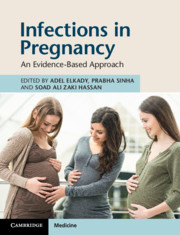Book contents
- Infections in Pregnancy
- Infections in Pregnancy
- Copyright page
- Contents
- Contributors
- Foreword
- Preface
- Section 1 Vaccination
- Section 2 Infections in Pregnancy
- Chapter 2 Viral Hepatitis
- Chapter 3 HIV Infection
- Chapter 4 Herpes Infections and Measles
- Chapter 5 Zika Virus
- Chapter 6 Parvovirus
- Chapter 7 Influenza
- Chapter 8 Cytomegalovirus
- Chapter 9 Dengue Fever
- Chapter 10 Rubella
- Chapter 11 Molluscum Contagiosum
- Chapter 12 Ebola
- Chapter 13 Chikungunya
- Chapter 14 Antibiotics during Pregnancy and Methicillin-Resistant Staphylococcus aureus (MRSA)
- Chapter 15 Gonorrhoea, Syphilis and Lymphogranuloma Venereum
- Chapter 16 Mycoplasma, Ureaplasma, Chancroid, Granuloma Inguinale (Donovanosis)
- Chapter 17 Genital Chlamydia trachomatis and Bacterial Vaginosis
- Chapter 18 Streptococcal Infection
- Chapter 19 Enterococci and Bacterial Infections
- Chapter 20 Listeriosis
- Chapter 21 Urinary Tract Infection
- Chapter 22 Infections and Preterm Labour
- Chapter 23 Appendicitis in Pregnancy
- Chapter 24 Complications Associated with Legal Termination of Pregnancy
- Chapter 25 Tuberculosis
- Chapter 26 Vulvo Vaginitis, Candida (Yeast) Infection
- Chapter 27 Malaria
- Chapter 28 Parasitic Infestation: Protozoa
- Section 3 Postpartum Infections
- Index
- References
Chapter 20 - Listeriosis
from Section 2 - Infections in Pregnancy
Published online by Cambridge University Press: 11 October 2019
- Infections in Pregnancy
- Infections in Pregnancy
- Copyright page
- Contents
- Contributors
- Foreword
- Preface
- Section 1 Vaccination
- Section 2 Infections in Pregnancy
- Chapter 2 Viral Hepatitis
- Chapter 3 HIV Infection
- Chapter 4 Herpes Infections and Measles
- Chapter 5 Zika Virus
- Chapter 6 Parvovirus
- Chapter 7 Influenza
- Chapter 8 Cytomegalovirus
- Chapter 9 Dengue Fever
- Chapter 10 Rubella
- Chapter 11 Molluscum Contagiosum
- Chapter 12 Ebola
- Chapter 13 Chikungunya
- Chapter 14 Antibiotics during Pregnancy and Methicillin-Resistant Staphylococcus aureus (MRSA)
- Chapter 15 Gonorrhoea, Syphilis and Lymphogranuloma Venereum
- Chapter 16 Mycoplasma, Ureaplasma, Chancroid, Granuloma Inguinale (Donovanosis)
- Chapter 17 Genital Chlamydia trachomatis and Bacterial Vaginosis
- Chapter 18 Streptococcal Infection
- Chapter 19 Enterococci and Bacterial Infections
- Chapter 20 Listeriosis
- Chapter 21 Urinary Tract Infection
- Chapter 22 Infections and Preterm Labour
- Chapter 23 Appendicitis in Pregnancy
- Chapter 24 Complications Associated with Legal Termination of Pregnancy
- Chapter 25 Tuberculosis
- Chapter 26 Vulvo Vaginitis, Candida (Yeast) Infection
- Chapter 27 Malaria
- Chapter 28 Parasitic Infestation: Protozoa
- Section 3 Postpartum Infections
- Index
- References
Summary
In the general population, Listeria infection is relatively uncommon, with a prevalence of approximately 4 per million in Canada, 0.27 per million in the USA and between 0.1 and 11.3 per million population in different parts of Europe.
Pregnant women have a 12- to 18-fold increased risk in pregnancy (12/100 000), compared with the non-pregnant population.
Out of all infections with Listeria, 16–27 per cent occur in pregnant women.
The exact cause of its higher prevalence in pregnancy is not known. Immunosuppression associated with pregnancy results in suppression of cell-mediated immunity in the placenta, due to high concentration of maternal hormones and other unknown mechanisms.
Approximately 20 per cent of Listeria infections involve neonatal infection with potentially severe complications, therefore it is important to stop the outbreaks in pregnant woman and the unwanted consequences for their unborn fetuses.
- Type
- Chapter
- Information
- Infections in PregnancyAn Evidence-Based Approach, pp. 121 - 128Publisher: Cambridge University PressPrint publication year: 2019

